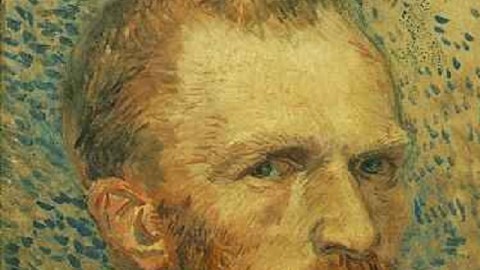A Van Gogh for Our Times

As the times go, so goes Van Gogh. Toiling in relative obscurity during his life, known by fellow painters but not by the public at large, Vincent Van Gogh’s greatest career move was dying in 1890. First Theo, his brother, then Jo, Theo’s widow, spread the gospel of Vincent and transformed the strange man who made strange pictures into the embodiment of the tortured artist cruelly snubbed by a public unprepared to recognize his genius. As the times changed, that essential picture of Vincent adjusted to the times: pre-war German Expressionists adopted him as a fellow angst-master, Irving Stone’s Lust for Life pictured a pious painter perfectly portrayed in film by the young, manly Kirk Douglas, Don McLean warbled “Starry, Starry Night” for a fragile Vincent from the trippy Sixties. Just as those various Vincents grow tired and quaint, Steven Naifeh and Gregory White Smith come along with a Van Gogh for our times in Van Gogh: The Life. The Vincent in their pages reflects our times: conflicted, troubled, and, now, digital.
Naifeh and Smith, authors of the Pulitzer Prize-winning biography, Jackson Pollock: An American Saga, brought the raw power of modern research technology to the subject of Van Gogh. For the past 10 years, Naifeh and Smith and their team of 20 translators and researchers scoured the world for every scrap of Van Gogh information, including unprecedented access to unpublished family letters in the Van Gogh Museum’s archives. For those who have fallen in love with Van Gogh’s unforgettable letters, the inclusion of letters by Vincent never before translated into English will be a pleasure for completists. Coming in at a little under one thousand pages, Van Gogh: The Life reigns as the new heavyweight champion of Van Gogh studies and sets a new standard for scholarship for biographies in general.
But all that biographical research would be worthless without a novelist’s touch. Beginning breathlessly with a scene of Theo rushing to the dying Vincent’s side, Naifeh and Smith grab you from the beginning and never let go. “This was the Vincent that Theo had grown up with: adventurous guide, inspiration and scold, encyclopedic enthusiast, droll critic, playful companion, transfixing eye,” they write, imagining Theo’s thoughts. “How could this Vincent, his Vincent, have turned into such a tormented soul?” The rest of the book answers that question, and offers a lineup of culprits and accomplices to the crimes against Vincent’s mind (including himself) for the reader to pick from.
The first significant suspect to emerge is Vincent’s mother, Anna. “Unremittingly humorless in her dealings with both family and friends,” Anna, as the authors picture her, “grew melancholy easy and… [could find] hazard or gloom at the end of every rainbow.” Imagine the vibrancy of Vincent’s imagination born to that rainbow-killing spirit and you see the roots of many of his troubles. Naifeh and Smith steer clear of all the Oedipal clichés biographies can fall into and present an honest picture of a woman who instilled a set of family values that stifled rather than nourished her children. All the Van Gogh children, not just Vincent, continued to write mother obsessively once adulthood drove them from the nest as a way to stay connected and to solicit the motherly solace she refused to offer. During one of his darkest moments, Van Gogh painted his mother’s portrait and affixed the kindly smile of approval he never enjoyed in reality.
Theo—the legendarily patient brother of the genius—looks a lot different through the eyes of these authors. A dutiful son, Theo accepted financial responsible for Vincent to free his aging parents from the stress of dealing with the drama. The tension between Theo and Vincent comes through the correspondence, which are usually seen as one long brotherly love letter. Theo actually begged Vincent to paint more commercially saleable works, to which Vincent reacted by defiantly doing the opposite, leading one to wonder if the great style came from spite. When Vincent finally died, Theo’s guilt turned into an obsession to promote Vincent’s art through his art world connections. After Theo’s death a year after Vincent’s, Theo’s widow Jo carried the torch for both brothers, even moving Theo’s body from a Utrecht cemetery to reside next to Vincent’s Auvers’ grave in 1914 after almost a quarter century of separation. The idea that they could have ever been apart seems impossible today, but emphasizing the reality that they were is an important feature of this new biography.
When it comes to the art itself, the story of bold genius going his own way finds some detours. Although he hit upon a unique new style, “Vincent was the most reluctant of pioneers,” Naifeh and Smith explain, “more shunned than shunning; ostracized from the art he loved by the shortcomings of his hand just as he was ostracized from his families, both real and adopted, for the nonconformity of his behavior.” The most famous Post-Impressionist didn’t emulate or react to Monet or Cezanne in this analysis, but hoped to channel the romanticism of Delacroix for a new age, except that his technical skills made it impossible, while making the style we know him for possible. Van Gogh’s art becomes a cosmic accident as fleeting, random, and beautiful as a streaking comet.
Above all, a different Vincent emerges in this biography. Saint Vincent disappears and the human appears. The lonely little boy who obsessively but vainly sought his mother’s love grows into the troubled man continually constructing new families wherever he went, whether those around him wanted to or not. The lover of nature and omnivorous consumer of literature and art remains in vivid detail, but particulars of the erstwhile lover with a prostitution problem (the index not only lists “prostitutes,” but also breaks it down by eight different cities) makes you see Vincent in a less starry, starry light.
That light, however, reflects our modern preoccupation with knowing everything about our celebrities. Vincent warts and all is actually progress, not only for him but for all people suffering from mental illness or a disability such as his epilepsy who receive the “Helen Keller treatment.” Helen Keller’s remarkable story became a prison over time in which her wondrousness excluded her desire for a normal life. Similarly, Vincent’s wondrousness as an artist has entombed him from his own life. This biography gives Vincent back a normal life, or as normal as he could have had. The most controversial part of this new biography—an alternate theory of the circumstances of Van Gogh’s death—appears as an appendix, but even that alternate version gives us an idea of how tough it was to be Vincent when he was alive, and how much tougher it’s been to be him dead.
Finally, what makes Van Gogh: The Life truly representative of today is how it’s taken biography and gone digital. Realizing that the 28,000 notes to the text would fill more than 6,000 pages, the authors saved a forest and went digital by posting all the notes online. In addition, every image from the book is also online, as well as a selection of additional Van Gogh-related images they couldn’t fit in. A family tree (with photos) and searchable list of people related to the book round out the online offerings, to which the authors promise to continually add.
As Naifeh and Smith state in their online mission statement, “Our aim is not only to enhance the experience of reading Van Gogh: The Life, but also to provide content that is of interest to a larger audience of scholars, students, aficionados, and others attracted to the endlessly fascinating world and work of Vincent van Gogh.” The book’s accompanying website serves as an invitation and a challenge to future scholars and biographers. Here’s the raw materials, the authors say, let’s see what you can find. Van Gogh: The Life stands as the new definitive biography of Vincent Van Gogh and will be the basis for the next generation’s version of Vincent, too.
[Image:Vincent Van Gogh. Self-Portrait (detail), 1887.]
[Many thanks to Random House for providing me with a review copy of Van Gogh: The Life by Steven Naifeh and Gregory White Smith.]





